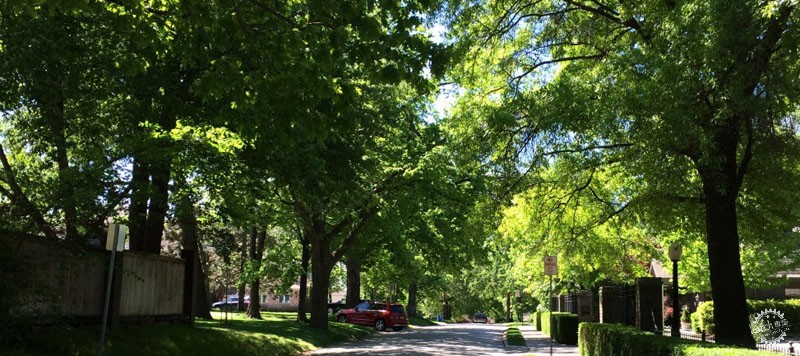
林荫大道的魔力
The Magic of Tree-Lined Streets
由专筑网pilewyj,李韧编译
是时候该说说树了。
为什么? 因为我住在美国俄克拉荷马州的塔尔萨,那里现在的温度是华氏96度,湿度是50%,热度指数是109度。科学地说,这里的天气非常炎热,当人们走路淌大汗的时候,没有谁会关心城市的发展。
有人调侃,疯狗和英国人才会在正午时分出门...
几天前,尽管天气很热,我还是决定去跑几圈。因为近两次散步都在我家一英里半的范围内,所以这次我想骑上自行车去远一点。在一英里左右,街区里的行道树为我遮挡了许多阳光。在阴凉和微风的吹拂下,这段骑行非常舒适。“还不错嘛。”我想,似乎忘了出门前内心对于高温的不安。
不幸的是,我的乐观保持不了多久,特别是在我进入一段没有一点绿荫的街区后。
如果你在火刑柱上被烧死了,那只是一场干热。而这条街给人的感觉,像是在蒸桑拿,是一种比被煮之后再油炸更难受的痛苦。
It’s time to talk about trees.
Why? Because I live in Tulsa, Oklahoma, where it’s currently 96 degrees Fahrenheit with 50% humidity, resulting in a heat index of 109 degrees. This is just a scientific way to say that it’s hotter than hell-fired habaneros out there. And to be frank, nobody cares about walkable urbanism when they’re sweating through their clothes.
Mad Dogs and Englishmen Go Out in the Midday Sun…
A few days ago, despite the soaring temperatures, I decided to run a couple errands. Since both trips were within a mile and a half of my house, I hopped on my bike. For the first mile or so, I was able to cut through neighborhoods where mature trees shaded my route. With the shade and a nice breeze, the ride was amazingly comfortable. “This isn’t so bad,” I thought, casually dismissing all the heat warnings I’d heard earlier in the day.
Unfortunately, my sanguine attitude evaporated the moment I emerged from the sanctuary of a shaded neighborhood into a treeless, asphalt furnace.
No disrespect to Joan of Arc, but at least if you get burned at the stake, it’s a dry heat. This was more like being boiled. And then fried. If you built a sauna inside a kiln, it would feel something like this street.
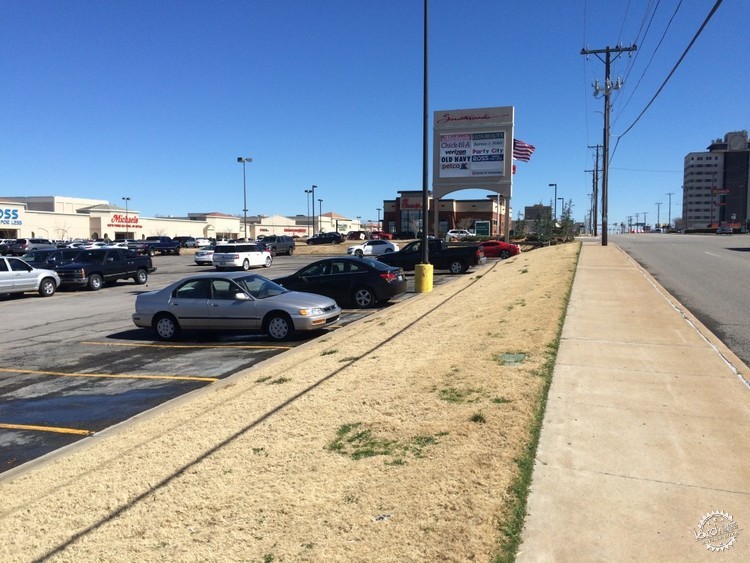
恶劣的步行环境
在炎热的天气里,唯一比在没有树荫的街道上骑车更难过的事情就是在这条路上行走了。骑行会给自己带来微风,可以起到降温的作用。而在这样的街道上如果仅仅是步行,不仅不宜人,而且甚至会危及生命。
所以想要设计“设施完备的街道”和“畅通的交通”时,一定要考虑林荫树的重要性。因为在炎热的天气下,如果没有树荫,这些理念根本没有办法达成。有车的人会开车,没有车的人则没法躲避高温,要不然就只能选择呆在家里。
如果你从没有考虑过把行道树当作一个社会问题看待,那当你在烈日下走在一条没有树荫的道路上或者等车的时候,你的想法一定会改变。
A Hostile Walk Environment
The only thing worse than biking on a treeless street on a scorching hot day is walking on one. Since cycling creates its own breeze, you get some relief through evaporative cooling. You also reach your destination faster, which minimizes the agony. Without trees, walking along a typical city street in the summer heat is not only unpleasant, it can be life threatening.
So when you talk about “complete streets” and “active transportation” be sure to mention the importance of canopy trees. Because in a hot climate, if you don’t have shade, these options are moot. Everyone with a car is going to drive. Everyone without a car is going to suffer, or stay home.
And if you’ve never thought about street trees as a social justice issue, an afternoon spent in the summer sun walking to (and waiting for) the bus might just change your mind.
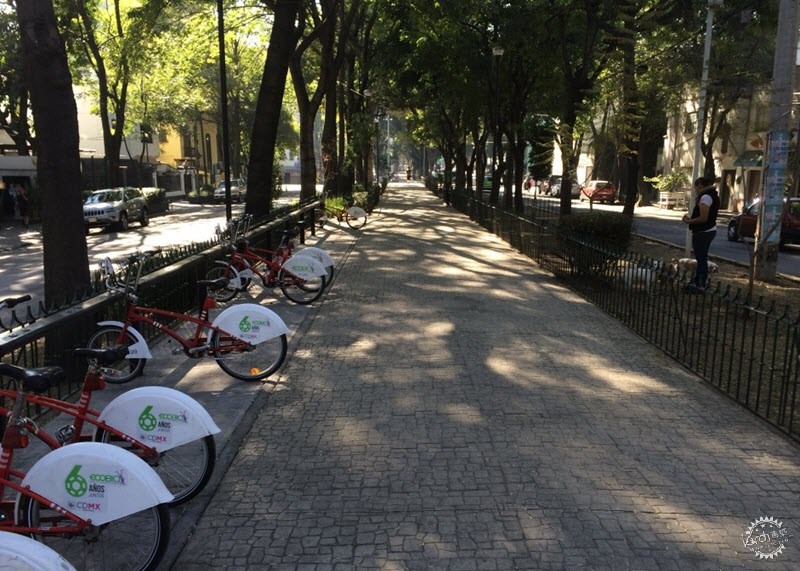
虽然树只是简单的元素,这并不只是在说停车位附近低矮的灌木,而是真正的树。那种能为街道创造树荫的大树。它们能为人们将缺乏安全感的空间变得舒适。
Simply put, trees matter. And I don’t mean those shrubs people stick in parking lots to fulfill the landscaping requirements of the zoning code. I mean real trees. The kind that line sidewalks and create canopies over the street. The kind that turn inhospitable environments into pleasant places for people.
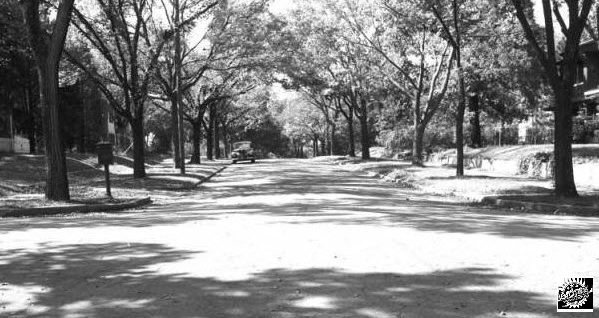
城市街道行道树的衰减
我们的祖先当年还没有发明空调或者汽车,但他们已经懂得行道树的重要性。他们知道城市离不开行道树。因此,很久以前,就有城市颁布规范要求种植行道树。
但是在Tulsa,城市的森林日益衰减。在我经历的这段日子里,许多自然灾害已经对我们的行道树造成了很大的打击。荷兰榆树病、风灾、冰暴摧毁的树木以及为建设电网而砍伐的树木,已经使整个城市的绿化遭受重创。
不是所有人都愿意将这些树复原。许多人只是不喜欢为复原倒掉的树再次买单。我不知道一棵树栽倒在森林里是否会发出声音,但是当它压垮屋顶时,人们一定会为此费尽心力。有些人是真的负担不起,然而有些人则是不想费心思。还有一些人,可能会选择另一个不太适合的树种来替代原来的树,或者移栽到别的地方。
The Decline and Fall of the Urban Street Tree
Our ancestors, who hadn’t yet invented air-conditioning or automobiles, understood this. They knew that city building and tree planting went hand in hand. Thus, long before the introduction of zoning codes, cities passed laws requiring trees to be planted along the public rights-of-way.
Unfortunately, here in Tulsa, our urban forest has suffered in recent decades. In my lifetime alone, a number of tragic events—both man-made and natural—have decimated our once dignified tree-lined streets. Dutch Elm Disease, wind storms, ice storms, and butchering by unqualified tree-trimmers—many hired by the local electric company to protect power lines—have destroyed countless thousands of mature trees throughout the city.
Not everyone has re-planted. Many people simply don’t relish dealing with them after the expensive ordeal of removing massive downed trees from their property. (I don’t know if a tree makes a sound when it falls in the forest; but when it crushes your roof, it leaves a lasting impression.) Some can’t afford the luxury of replanting. Others, like many rental property owners, just don’t bother. And those with the inclination and financial resources to replant may select an inappropriate species or ineffective location for their replacement trees.

在制造树冠景观方面,公共政策中有许多限制。分区法适用于私人财产,而对于城市共有财产并不适用,因此为创造令人愉快的步行环境,所需的城市道路用树只能栽在离街道很远的地方。工程标准要求道路旁边有清晰的视线,这样又限制了行道树的位置。当地电力公司建议在电线附近只能种植低矮的装饰性树木,而这些低矮的树木又占领了主干道。总之,这些规则使树冠林荫效果的可能性大大降低,整个城市的行人和骑行者也将无法享受林荫带来的好处。
行人舒适感建立于行道树和绿线之上
城市的发展还有很长的路要走,去弥补已经失去的树木带来的损伤。但我们必须贯彻栽植更多的行道树,因为行道树使街道更适合步行和骑行,也更美观。总之它们能促就更好的街景。
其实还有其他的方法可以阐述行道树对城市和个人的好处。对当今社会来说,行道树的功效最重要的是减少雨水径流、改善空气质量和减少臭氧和二氧化碳等温室气体的排放,还能改善行人和司机的安全,当然,它也可以增加财产价值和为商业销售带来更高税收。
When it comes to creating tree canopies, many obstacles are enshrined in public policy. Zoning codes apply to private property, not the city’s right-of-way, so required trees are often set back too far from the street to create a pleasing pedestrian environment. Engineering standards require clear sight lines next to the road, which prevents street trees from being located where they are most effective. And the local power company recommends planting short, ornamental trees near power lines, which, all too often, are located along arterial streets. Together, these rules eliminate the possibility of creating or restoring a tree canopy that would benefit pedestrians and cyclists throughout the city.
Beyond Pedestrian Comfort: Street Trees and the Bottom Line
We have a long way to go to replace what has been lost. But we have to keep working because street trees make places more walkable and bikeable and beautiful. All of which should be reason enough to fight for better streetscaping.
But there are myriad other ways in which street trees benefit cities and individuals alike. Among the most important to municipalities are significant reductions in stormwater runoff; improved air quality and reductions in greenhouse gases like ozone and carbon dioxide; improved pedestrian and driver safety; and higher taxes resulting from increased property values and commercial sales.
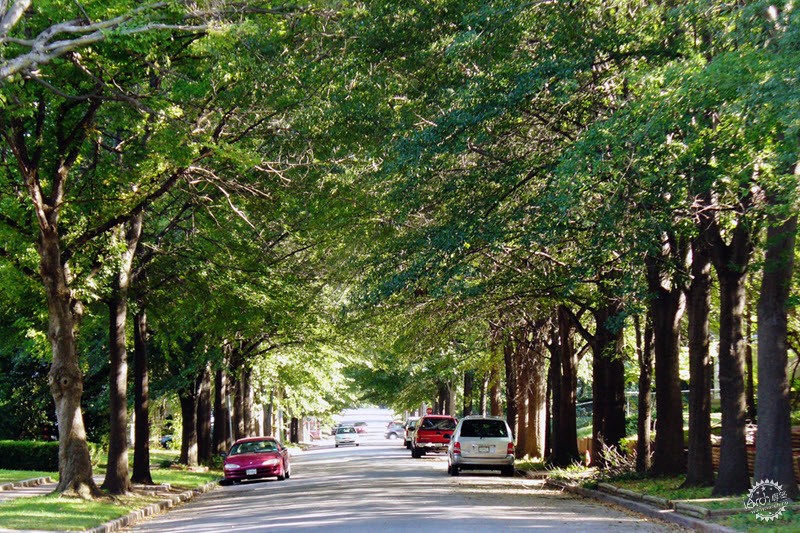
为了实现这些好处,我们需要认真考虑树木在城市的种植,而不是随意裁决它的种类和位置。我们需要植物繁茂,为城市道路带来更多价值,环境保护局制定的指南也是有参考的必要,因为它能科学地让行道树长久生存。
不管你是关心环境、节能、财产价值、公共卫生,还是你所在城市的地面绿线,在街道旁种一棵树,人们的获益并不只是在步行或是骑行时。
To achieve these benefits, we need to take trees seriously. Especially in urban areas, you can’t just stick a tree in the ground and expect it to prosper. For cities interested in maximizing their return on investment of street trees, the EPA has created a guide focused on design considerations that will allow street trees to survive and thrive well into maturity.
Whether you care about the environment, energy savings, property values, public health, or your city’s bottom line--plant a tree by the street. You’ll make sweaty cyclists and pedestrians happy for generations to come.
|
|
